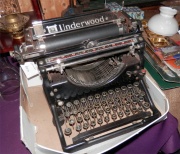Underwood Typewriter Co
The Underwood Typewriter Company was a manufacturer of typewriters head-quartered in New York City, New York. Underwood produced what is considered the first widely successful, modern typewriter
From 1874 the Underwood family made typewriter ribbon and carbon paper, and were among a number of firms who produced these goods for Remington. When Remington decided to start producing ribbons themselves, the Underwoods decided to get into the business of manufacturing typewriters.
The original Underwood typewriter was invented by German-American Franz Xaver Wagner, who showed it to entrepreneur John Thomas Underwood. Underwood supported Wagner and bought the company, recognising the importance of the machine. Underwood No. 1 and No. 2s, made between 1896 and 1900, had "Wagner Typewriter Co." printed on the back.
1900 The Underwood No. 5 was launched and has been described as "the first truly modern typewriter". Two million had been sold by the early 1920s, and its sales “were equal in quantity to all of the other firms in the typewriter industry combined”. When the company was in its heyday as the world's largest typewriter manufacturer, its factory at Hartford, Connecticut was turning out typewriters at the rate of one each minute.
c.1910 Underwood started adding addition and subtraction devices to their typewriters
Philip Dakin Wagoner was appointed president of the Elliott-Fisher Company after World War I (1914-1918). Elliott-Fisher became the parent of the Underwood Typewriter Company and the Sundstrand Corporation.
In 1927 Wagoner reorganized the company into Underwood-Elliott-Fisher, which later became the Underwood Corporation. The reorganization was completed in December 1927. John Thomas Underwood was elected chairman and Wagoner president of Underwood Elliott-Fisher.
In the years before World War II, Underwood built the world's largest type writer in an attempt to promote itself. The typewriter was on display at Garden Pier in Atlantic City, New Jersey for several years and attracted large crowds. Often, Underwood would have a young woman sitting on each of the large keys. The enormous typewriter was scrapped for metal when the war started.
During World War II Underwood produced M1 carbines for the war effort.
In 1945 Wagoner was elected chairman of the board of Underwood, and Leon C. Stowell was elected president. Wagoner remained chief executive. Olivetti bought a controlling interest in Underwood in 1959, and completed the merger in October 1963, becoming known in the US as Olivetti-Underwood with headquarters in New York City, and entering the electromechanical calculator business. The Underwood name last appeared on Olivetti portable typewriters produced in Spain in the 80s
















